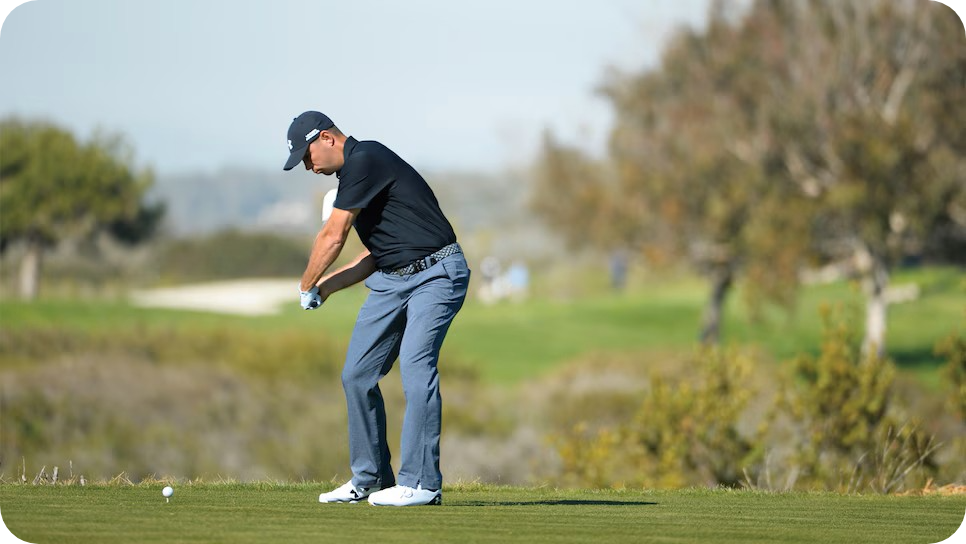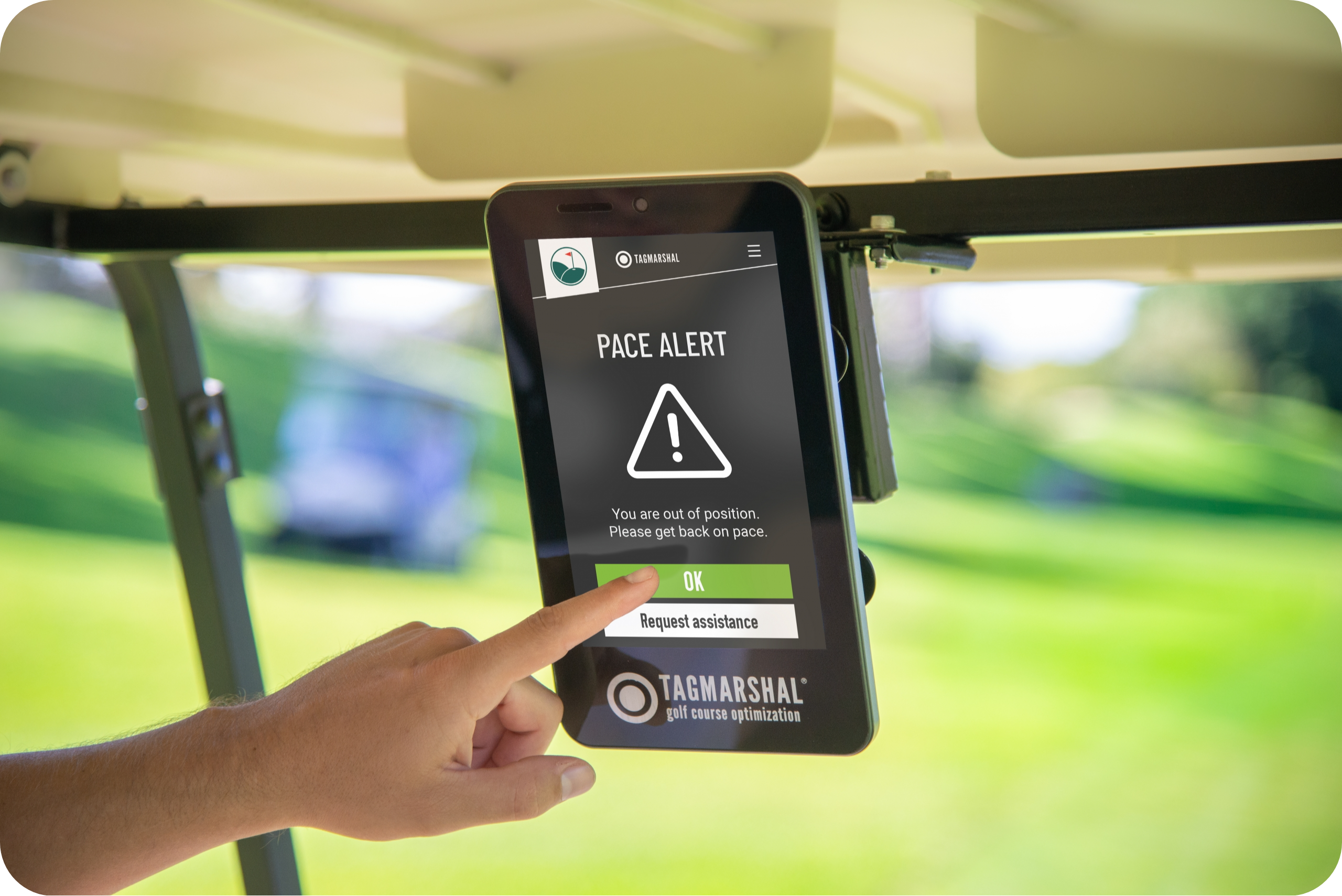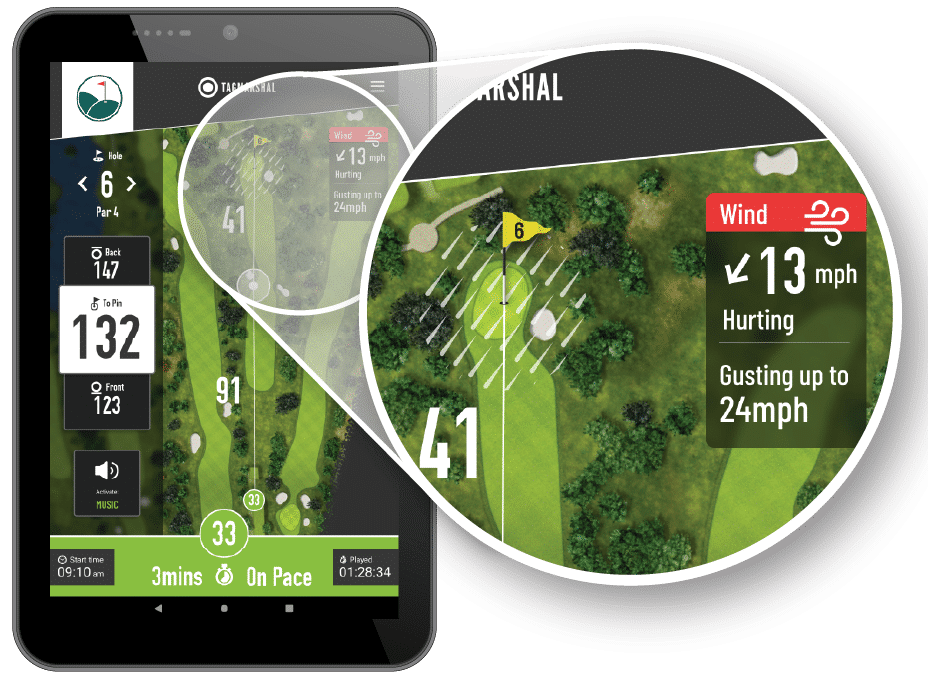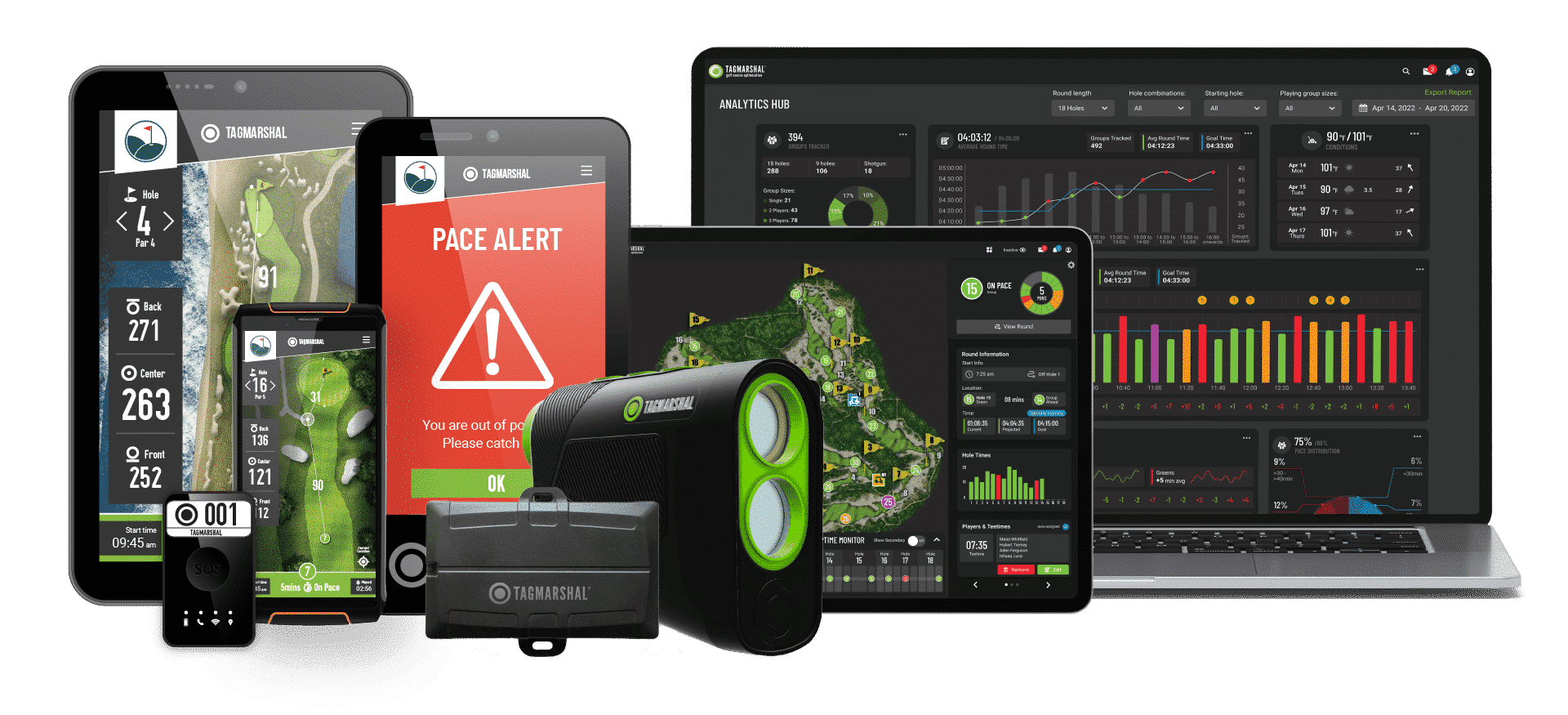Golf Cart GPS and Golf Swing Fundamentals: Tips, Drills, and Common Mistakes
Even in the modern era of golf, where smart technology and golf cart GPS have become integral to the game, the basics are as important as ever. Whether you’re new to golf or a seasoned veteran, working on your golf swing fundamentals is a key part of maintaining consistency and getting the most out of your rounds. Every golfer can benefit from working on the basics, and rounds are bound to be more enjoyable when you’re comfortable with your swing.
In this article, we cover practical tips, targeted drills, and some common mistakes that golfers make on the course. The proven techniques and advice provided in this guide can help you build a swing that is both powerful and unique to your style. We’ll also discuss how Tagmarshal’s industry-first technology can help golfers who are working on these fundamentals.
Golf Cart GPS and Golf Swing Fundamentals: Understanding The Fundamentals
Your golf swing is at the core of every shot you take, and understanding the fundamentals is an important part of maintaining consistency, accuracy, and distance. A good golf swing is a combination of mechanics, timing, and balance.
When you’re comfortable with your swing, you can hit controlled and precise shots. While smart data, golf cart GPS technology, and a range of other tools are helping golfers get better on the course, the first step to getting your golf swing right is to have a clear understanding of the basics.

Your grip, stance, backswing, downswing, and follow-through are all important parts of achieving a solid swing. The best way to improve your swing is to practice working on each element, focusing on quality rather than just quantity. Let’s take a deeper look at the key fundamentals.
Grip
A proper golf grip aims to control the clubface. Your grip is your only physical connection to the club, making it one of the most important fundamentals to master.
There are three common standard golf grips: the Overlapping Grip (Vardon), the 10-finger Grip, and the Interlocking Grip. While these methods are widely taught, many golfers use slight variations within each style, such as a stronger or weaker grip position, to suit their swing, body type, and shot shape preferences.
- The Overlapping Grip (Vardon): The pinky of your trail hand rests on top of the gap between the index and middle fingers of your lead hand. This method is often favored by professional golfers.
- The Interlocking Grip: The pinky of your trail hand interlocks with the index finger of your lead hand. This method is usually more popular for golfers with smaller hands.
- The 10-Finger Grip: The 10-finger grip, also referred to as the baseball grip, is often seen as the simplest grip style. All 10 fingers are on the club, creating more contact between the hands and the club. This method is often favored by beginner golfers.
Across all of the above styles, your grip pressure should generally be both light and secure. It should be firm enough to control the club without tensing your forearms. Your hands should not separate, and the club should not twist during the swing, as this can mess with your overall control.
Stance
Your stance is just as important as your grip. Getting your stance right is the foundation for balance, stability, and proper body rotation. Your feet, hips, and shoulders should be parallel to your target line for best results.
The ball position will vary, depending on the club. When using a driver, position it just inside your lead heel. With mid-irons, it should be centered for optimal launch. With short-irons or wedges, it should be placed slightly back of the center for more control.
In terms of posture, make sure to bend slightly from the hips (not the waist) with a straight back, your knees slightly flexed, and your weight evenly distributed. If you’re standing too upright or you are too hunched over, your golf swing will suffer.
Backswing
The backswing is where you store the energy that will be released on the downswing. The first part of the backswing is known as the takeaway. The goal of the backswing is to get into the perfect position to start your downswing, and rushing your backswing will hurt your swing tempo.
Begin with a smooth takeaway, keeping the club low to the ground for the first foot of movement. Let your shoulders turn fully while your hips rotate naturally. As a general reference point, when your hands and the club are waist-high, the toe of the club should be pointing straight up in the air. At the top, your club should basically be parallel to the ground with your weight shifted to your trail foot.
If you end up over-rotating or crossing the line at the top, you may lose control, leading to poor ball flight when you take your shot.
Downswing

Once you’ve mastered getting to the top of your backswing with ease, your focus should shift to your downswing transition towards the ball. The downswing essentially turns the energy stored in the backswing into speed and power.
The first thing you should feel during your downswing is your hips rotating back towards the ball. The downswing begins from the ground up, and your weight should be shifted to your lead foot as your hips start rotating towards the target. Your lower body leads, and is followed by the torso, arms, and then the clubhead at impact.
The impact position should depend on the club. For irons, your hands should be ahead of the clubhead at contact to compress the ball. For the driver, many players benefit from having the clubhead just slightly behind the hands at impact, which can help launch the ball higher. Hanging back or flipping the wrists can lead to inconsistent strikes.
You should make sure that your weight transfer is moving towards your front foot. Often, golfers make the mistake of coming “over the top,” where the upper body dominates the move, which hurts the distances you can achieve from your shot.
Follow-Through
Finally, a good follow-through is a sign of a smooth and balanced swing. Despite already making contact with the ball, you still need to finish the swing. The follow-through should not be looked at as an afterthought, but as a key part of a proper golf swing.
Your swing should finish with your chest and belt buckle facing the target, and your weight fully shifted onto your lead side with the club wrapped high around your lead shoulder. If you manage to hold your follow-through for a few seconds without losing balance, you can take it as a sign of a balanced and smooth golf swing. If you realize that you’re cutting your follow-through short, it’s often a sign that you lost speed before impact, which may hurt your shot distance and accuracy.
Golf Cart GPS and Golf Swing Fundamentals: Best Practice Drills For New Golfers
As is the case with most things in life, the best way to improve your swing is to practice. For beginner golfers, here are a few practice drills to help:
Alignment Stick Drill/Basic Alignment Drill: The alignment stick drill is to help train your eyes and body to aim properly. First, place an alignment stick on the ground along your target line. You can use a spare golf club for this. As you practice your swing, make sure that your feet, hips, and shoulders run parallel to the stick. Over time, the visual cues will teach you to set up square to your target without having to rely on guesswork.
Half-Swing Drill: The half-swing drill is a great practice drill for beginner golfers. It teaches you to control the club and achieve a consistent swing. Swing back only halfway, then follow through fully. The shorter motion helps you improve on the proper sequencing of the hips, torso, and arms. The half-swing drill is also a great warmup exercise to do before rounds as a method of getting your timing in sync.

Feet Together Swing Drill: This drill is focused on balance, helping you to stay centered and swing with control. Stand with your feet together, knees slightly bent. Do half-speed swings and focus on keeping your feet side by side, working your way to full swings. As any swaying will throw you off balance, your body naturally learns to maintain a stable base.
Slow-Motion Swing: The slow-motion swing is a simple but effective drill that helps you identify and correct mechanical flaws in your swing. During a slow-motion swing, all of your movements should be deliberate and slow. Move through each phase (grip, stance, backswing, downswing, and follow-through) while paying close attention to your balance, tempo, and body positioning, making adjustments where necessary.
Impact Bag Drill: The impact bag drill is for developing a consistently powerful strike. Place a padded bag where the ball would be and focus on achieving the ideal impact position: weight forward, hands ahead of the clubhead, and a square clubface.
Golf Cart GPS and Golf Swing Fundamentals: Common Mistakes and How To Fix Them
Even seasoned golfers can fall back into bad habits and common mistakes. By recognizing the common mistakes that golfers make, you can make the necessary corrections in your own game and improve.
Overswinging: Overswinging can cause you to lose control. Often, when golfers try to hit the ball as hard as possible, they end up overswinging and losing balance. To fix this, shorten your backswing slightly and focus on maintaining tempo. Your swing should be smooth and controlled, and not just a wild lash at the ball.
Swaying Instead of Rotating: Golfers often shift their entire body sideways during a backswing instead of turning around a stable spine, which makes it difficult to return the club to the ball consistently. To fix this, focus on keeping your head steady and turning your shoulders around your spine instead of moving side-to-side.

Too Much Tension in Hands and Arms: Too much tension in your hands and arms can lead to gripping the club too tightly. If your grip is too tight, it restricts wrist hinge, slows club speed, and creates tension throughout the swing. To fix this, maintain a light and controlled pressure on the grip, firm enough so the club is not moving around in your hands, but loose enough to keep your forearms relaxed.
Lifting the Head Too Early: Golfers sometimes lift their heads before impact, which can lead to topping the ball. To fix this, focus on keeping your eyes on the spot where the ball sits until after your follow-through.
How Tagmarshal’s Golf Cart GPS Helps Golfers On The Course
Tagmarshal is the industry leader in golf course optimization, giving courses full, real-time operational oversight and reporting that allows operators to improve the player experience as a whole. While much of Tagmarshal’s technology is designed for course management, it also offers tools that can help golfers refine and improve their game through precise, relevant data.
2Way Cart Screens
Tagmarshal’s 2Way cart screens offer more than just basic golf cart GPS features. They provide accurate, to-the-pin yardage with military grade GPS technology. This means that you can trust the distances displayed for every shot and use them to make informed choices on the course.

If you often face 140-yard approaches but fail to get close, you can dedicate time to focus specifically on improving your swing for that specific distance. With this targeted approach, over time, you will see real on-course improvement.
WindTag

conditions, club, trajectory, and target. Using precise wind speed and directional data, along with your chosen club, shot trajectory, and intended target, WindTag offers smart recommendations for club selection and shot strategy.
You no longer need to guess how much crosswind or headwind you’re dealing with, and can use the data offered to make informed adjustments before taking your shot. Alongside exact yardage readings, you can also make the best possible club choice for the current situation.
WindTag can also be used as a powerful development tool. When you can see how the wind impacts your shots over multiple rounds, you gain a deeper understanding of ball-flight and shot-shaping, which leads to better decision-making and more confident swings.
Tagmarshal’s golf cart GPS features give you precise data that helps you understand your habits. Knowing your tendencies on the course allows you to practice with purpose and continue to evolve your game.
Book A Golf Cart GPS Demo With Tagmarshal Today
Mastering your golf swing is a lifelong process, and understanding the fundamentals is at the heart of consistent play. Modern tools like advanced golf cart GPS systems and wind analysis features offer precise data that make this journey more seamless. Combining timeless swing mechanics with course-specific insights allows you to approach every shot with confidence.
While golf course technology, such as golf cart GPS and AI-driven data, continues to evolve, the basics are still as important as ever. For golfers looking to get better at these fundamentals, Tagmarshal’s 2Way cart screens and industry-first WindTag technology can be highly effective development tools.
Tagmarshal is the market leader in forward-thinking golf course technology, golf cart GPS, and on-course optimization. We provide courses with AI-driven, real-time operational oversight and reporting that improve the playing experience for everyone. To learn more about what we do, get in touch or book your demo today!
GIVE YOUR TEAM THE TOOLS TO OPTIMIZE OPERATIONS
Watch Demo
ABOUT TAGMARSHAL
Tagmarshal, the market leader in on-course optimization technology, provides courses with full, real-time operational oversight and reporting, giving golf operators the tools to manage pace and flow of play effectively, resulting in enhanced player experiences, increased efficiency through automation, and additional revenue generation.
Tagmarshal’s technology has collected over 100 billion data points from more than 95 million tracked and improved rounds of golf and has relationships with in excess of 900 partners, including Hazeltine, Whistling Straits, Baltusrol, Fieldstone, Bandon Dunes, The Old Course at St Andrews Links, Serenoa and Erin Hills.
Tagmarshal partners with several golf management groups, private, daily fee, public and resort courses, including 50 of the Top 100 courses, as well as many $40-$60 green fee courses, which are seeing excellent results using the system.
 WATCH DEMO
WATCH DEMO